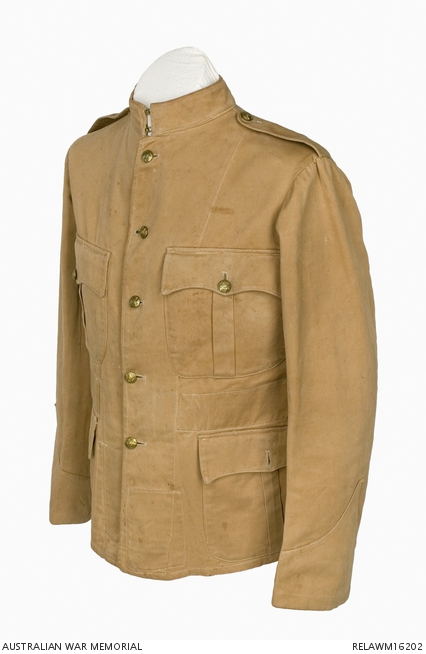| Place | Africa: South Africa |
|---|---|
| Accession Number | RELAWM16202 |
| Collection type | Heraldry |
| Object type | Uniform |
| Physical description | Brass, Cotton drill |
| Maker |
Unknown |
| Date made | c 1899 |
| Conflict |
South Africa, 1899-1902 (Boer War) |
Service dress jacket : Private W A Steel, 1st New South Wales Mounted Rifles



Khaki cotton drill jacket with square stand collar and pointed cuffs. Khaki shoulder straps each have single small British general service buttons made by 'PLAYER BROS. BIRMINGHAM'. Jacket has five of the same buttons down the front; two pleated breast pockets and two slightly larger pleated pockets below waist, all with shallow three-pointed flaps and a single button, although the button is missing from lower left pocket. All of the buttons are held in position with brass split rings. Collar, cuffs, pockets and fronts are all topstiched with white thread. Jacket is unlined except for the waistband which acts as a belt with two brass hooks and eyes at the corresponding free ends. At the lower inside fronts a patch of the same drill fabric sewn to each side, possibly a repair or reinforcement. The stitching shows through the facing of the jacket to the front and appears to have been done when the jacket was first made. All seams are French except at armholes. Collar fastens with two brass hooks and eyes. Above the left breast pocket is a small piece of Queen's South Africa Medal ribbon.
Watson Augustus Steel was born near Bathurst in 1861 and worked as an officer in the Bank of New South Wales at Temora before being transferred to Bungendore. Although his offer to serve in the Sudan war of 1885 was refused, he instead assisted with the raising of a local corps known as the Bungendore Corps of the Southern District Reserves. He joined the corps as a private but was commissioned as a first lieutenant in November 1885. He was recalled to Sydney by the bank in 1886. Steel volunteered for service as a trooper in the Boer War in December 1899 as part of a detatchment of 25 members of the NSW Mounted Rifles destined to join 'A' Squadron, one of the first Australian units to arrive at the front. He served under Lord Roberts in the advances at Bloemfontein, Johannesburg, Pretoria and North East to the Portuguese Africa border and was awarded the Queen's South Africa medal with three clasps; Transvaal, Orange Free State and Cape Colony. He returned to Australia in January 1901 and was discharged in April. He died in June 1946.